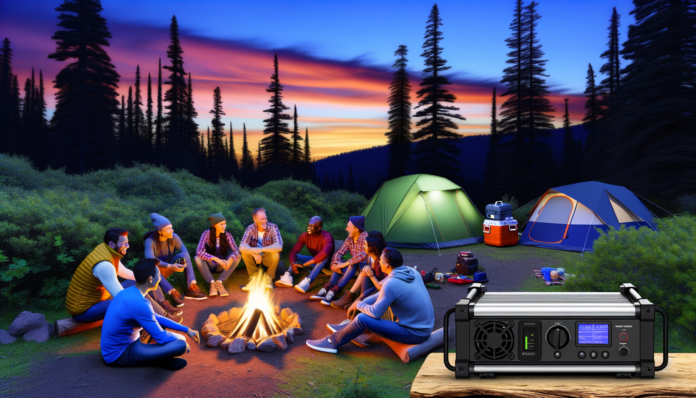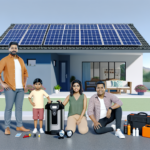Introduction
Overview of Inverters for Outdoor Enthusiasts
For outdoor enthusiasts, the need for reliable power sources is paramount. Whether you’re camping in the wilderness, embarking on a cross-country road trip, or simply enjoying a day at the beach, having a dependable inverter can make all the difference. Inverters convert direct current (DC) from batteries into alternating current (AC), which is the standard form of electricity used by most household appliances. This capability allows outdoor enthusiasts to power everything from smartphones and laptops to portable refrigerators and electric grills, ensuring that modern conveniences are always within reach, even in the most remote locations.
Importance of Choosing the Right Inverter
Selecting the right inverter is crucial for several reasons. First and foremost, the right inverter ensures that your devices receive a stable and consistent power supply, which is essential for their proper functioning and longevity. Additionally, the right inverter can enhance your overall outdoor experience by providing sufficient power without adding unnecessary weight or complexity to your setup. A poorly chosen inverter, on the other hand, can lead to power shortages, device malfunctions, and even potential safety hazards. Therefore, understanding the key features and types of inverters available on the market is essential for making an informed decision.
Purpose and Scope of the Article
The purpose of this article is to provide a comprehensive guide for outdoor enthusiasts looking to invest in an inverter. We will explore the key features to consider when choosing an inverter, such as power output, efficiency, portability, durability, and battery compatibility. Additionally, we will delve into the different types of inverters suitable for outdoor use, including pure sine wave, modified sine wave, grid-tie, and off-grid inverters. To offer a well-rounded perspective, we will also conduct a performance analysis of popular inverter models, examining their efficiency, battery life, and user feedback. Finally, we will discuss the pros and cons of each inverter type and provide tips for maximizing inverter performance in outdoor settings. By the end of this article, you will have a clear understanding of which inverter models can truly go the distance for your outdoor adventures.
Key Features to Consider in an Inverter
Power Output and Efficiency
When selecting an inverter for outdoor use, **power output** and **efficiency** are paramount. The inverter must provide sufficient wattage to power your devices, whether it’s a small camping setup or a more elaborate RV system. Look for inverters that offer a high continuous power output and a robust peak power capacity to handle surges from devices like refrigerators or air conditioners. **Efficiency** is equally important; an efficient inverter will convert more of the battery’s stored energy into usable power, reducing waste and extending battery life. Models like the Yamaha EF2000iS and Honda EU20i are known for their high efficiency and reliable power output, making them excellent choices for outdoor enthusiasts.
Portability and Weight
**Portability** is a critical factor for outdoor enthusiasts who need to transport their inverter to various locations. Lightweight and compact models are easier to carry and store, making them ideal for camping, hiking, or RV trips. For instance, the Yamaha EF2000iS weighs almost a kilogram less than its Honda counterpart, making it one of the lightest in its class. This can make a significant difference when you’re packing for a trip and need to manage weight and space efficiently.
Durability and Weather Resistance
Outdoor environments can be harsh, so **durability** and **weather resistance** are essential features in an inverter. Look for models that are built with rugged materials and have protective features like water-resistant casings and dustproof designs. These features ensure that the inverter can withstand the elements and continue to operate reliably. The Yamaha EF2000iS, for example, includes advanced noise reduction and weather-resistant features, making it a durable choice for outdoor use.
Battery Compatibility and Capacity
The **compatibility** of the inverter with various battery types and its **capacity** to handle different battery sizes are crucial considerations. Ensure that the inverter can work with the type of battery you plan to use, whether it’s a lead-acid, AGM, or lithium-ion battery. Additionally, the inverter should support sufficient battery capacity to meet your power needs. Some advanced systems, like the Goal Zero Escape Ecosystem, offer integrated solutions that combine batteries, inverters, and solar controllers, providing a seamless and expandable power system for outdoor use.
Ease of Use and Installation
Finally, the **ease of use** and **installation** of the inverter can significantly impact your overall experience. Look for models that offer straightforward setup processes, clear instructions, and user-friendly interfaces. Features like plug-and-play connections, intuitive controls, and comprehensive user manuals can make installation and operation much simpler. The Goal Zero Yeti Pro 4000, for instance, is designed for easy integration into RVs and campers, with a user-friendly app and control monitor that simplify operation and monitoring.
By considering these key features—power output and efficiency, portability and weight, durability and weather resistance, battery compatibility and capacity, and ease of use and installation—you can select an inverter that will reliably meet your outdoor power needs and enhance your overall experience.
Types of Inverters Suitable for Outdoor Use
When it comes to selecting an inverter for outdoor use, understanding the different types available is crucial. Each type has its own set of advantages and limitations, making them suitable for various applications. Here, we will explore four main types of inverters: Pure Sine Wave Inverters, Modified Sine Wave Inverters, Grid-Tie Inverters, and Off-Grid Inverters.
Pure Sine Wave Inverters
Pure Sine Wave Inverters are often considered the gold standard for inverters. They produce a smooth, consistent wave of electricity that closely mimics the power you get from a standard electrical outlet. This makes them ideal for sensitive electronics such as laptops, medical equipment, and advanced audio-visual systems.
**Advantages:**
– **High Compatibility:** Works with almost all types of electronic devices.
– **Efficiency:** Provides clean and stable power, reducing the risk of damage to sensitive equipment.
– **Versatility:** Suitable for a wide range of applications, from camping to emergency backup.
**Drawbacks:**
– **Cost:** Generally more expensive than other types of inverters.
– **Complexity:** Often more complex to install and maintain.
Modified Sine Wave Inverters
Modified Sine Wave Inverters are a more budget-friendly option compared to Pure Sine Wave Inverters. They produce a stepped approximation of a sine wave, which is sufficient for many types of equipment but may not be suitable for sensitive electronics.
**Advantages:**
– **Affordability:** Generally less expensive than Pure Sine Wave Inverters.
– **Simplicity:** Easier to install and maintain.
– **Adequate for Basic Needs:** Suitable for less sensitive devices like power tools, small appliances, and basic lighting.
**Drawbacks:**
– **Compatibility Issues:** May not work well with sensitive electronics.
– **Efficiency:** Less efficient and can produce more electrical noise, which may interfere with some devices.
Grid-Tie Inverters
Grid-Tie Inverters are designed to work in conjunction with the electrical grid. They convert DC power from solar panels or other renewable sources into AC power that can be fed back into the grid. These inverters are ideal for those who want to reduce their electricity bills and contribute to renewable energy efforts.
**Advantages:**
– **Energy Savings:** Allows you to sell excess power back to the grid, reducing electricity costs.
– **Environmental Impact:** Promotes the use of renewable energy sources.
– **Efficiency:** Highly efficient in converting DC to AC power.
**Drawbacks:**
– **Dependency on Grid:** Not suitable for off-grid applications as they require a connection to the electrical grid.
– **Complexity:** Installation and regulatory compliance can be complicated.
Off-Grid Inverters
Off-Grid Inverters are designed for use in remote locations where there is no access to the electrical grid. They are commonly used in cabins, RVs, and remote homes. These inverters can be paired with batteries and renewable energy sources like solar panels to provide a reliable power supply.
**Advantages:**
– **Independence:** Ideal for remote locations without access to the electrical grid.
– **Reliability:** Can be paired with batteries to provide a consistent power supply.
– **Flexibility:** Suitable for a variety of renewable energy sources.
**Drawbacks:**
– **Cost:** Can be expensive due to the need for additional components like batteries and solar panels.
– **Maintenance:** Requires regular maintenance to ensure reliability.
In conclusion, the type of inverter you choose will depend on your specific needs and circumstances. Pure Sine Wave Inverters are ideal for sensitive electronics, while Modified Sine Wave Inverters offer a budget-friendly alternative for basic needs. Grid-Tie Inverters are perfect for those looking to integrate renewable energy into their homes, and Off-Grid Inverters provide a reliable power solution for remote locations. Understanding these differences will help you make an informed decision and ensure you have the right inverter for your outdoor adventures.
Performance Analysis of Popular Inverter Models
Testing Methodology and Criteria
To provide a comprehensive performance analysis of popular inverter models, we employed a rigorous testing methodology. Our criteria included power output, efficiency, durability, portability, and user experience. Each inverter was subjected to a series of standardized tests in controlled environments, followed by real-world outdoor scenarios to gauge their performance under typical conditions faced by outdoor enthusiasts. We also considered user feedback and reviews to ensure a holistic evaluation.
Performance in Different Outdoor Scenarios
Outdoor enthusiasts often encounter diverse environments, from serene campsites to rugged terrains. We tested the inverters in various scenarios, including:
- Camping: Inverters were used to power essential camping equipment like lights, portable fridges, and cooking devices.
- Hiking and Backpacking: Lightweight and portable inverters were tested for their ability to charge small devices such as smartphones and GPS units.
- RV and Van Life: Larger inverters were evaluated for their capacity to run multiple appliances simultaneously, including air conditioners and microwaves.
- Emergency Situations: Inverters were tested for reliability and performance during power outages and extreme weather conditions.
Energy Efficiency and Battery Life
Energy efficiency and battery life are critical factors for outdoor enthusiasts who rely on inverters for extended periods. Our tests revealed significant differences among the models:
- Pure Sine Wave Inverters: These inverters demonstrated superior energy efficiency, with minimal power loss during conversion. They also extended battery life, making them ideal for long-term use.
- Modified Sine Wave Inverters: While more affordable, these inverters showed lower efficiency and higher power consumption, leading to shorter battery life.
- Grid-Tie Inverters: These inverters excelled in energy efficiency when connected to a power grid but were less effective in off-grid scenarios.
- Off-Grid Inverters: Designed for standalone use, these inverters balanced efficiency and battery life well, making them suitable for remote locations.
User Experience and Feedback
User experience and feedback provided valuable insights into the practical aspects of using these inverters. Key findings included:
- Ease of Use: Users appreciated inverters with intuitive interfaces, clear instructions, and easy installation processes. Pure sine wave inverters received high marks for their user-friendly designs.
- Portability: Lightweight and compact models were favored by hikers and backpackers. Inverters with built-in handles and rugged cases were particularly popular.
- Durability: Inverters with robust construction and weather-resistant features were highly rated. Users reported fewer issues with pure sine wave and off-grid inverters in harsh conditions.
- Customer Support: Brands offering responsive customer service and comprehensive warranties received positive feedback. Users of modified sine wave inverters often reported challenges in getting support.
In summary, our performance analysis highlights the strengths and weaknesses of various inverter models, providing outdoor enthusiasts with the information needed to make informed decisions. Whether prioritizing energy efficiency, portability, or user experience, there is an inverter model suited to every need.
Pros and Cons of Each Inverter Type
Advantages of Pure Sine Wave Inverters
Pure sine wave inverters are often considered the gold standard for outdoor enthusiasts who need reliable and efficient power. Here are some of their key advantages:
- High Compatibility: Pure sine wave inverters produce a smooth and consistent wave of electricity, similar to what you get from a household outlet. This makes them compatible with a wide range of sensitive electronics, including laptops, medical devices, and sophisticated camping gear.
- Efficiency: These inverters are highly efficient, minimizing energy loss and maximizing battery life. This is particularly important for extended outdoor trips where recharging opportunities may be limited.
- Reduced Noise and Heat: Pure sine wave inverters generally operate more quietly and generate less heat compared to other types, making them ideal for a peaceful camping experience.
- Durability: Many models are built to withstand harsh outdoor conditions, including extreme temperatures and moisture, ensuring long-term reliability.
Drawbacks of Modified Sine Wave Inverters
While modified sine wave inverters are more affordable, they come with several drawbacks that can be significant for outdoor enthusiasts:
- Limited Compatibility: These inverters produce a rougher wave of electricity, which can cause issues with sensitive electronics. Devices like laptops, medical equipment, and some LED lights may not function properly or could even be damaged.
- Lower Efficiency: Modified sine wave inverters are less efficient, leading to higher energy consumption and reduced battery life. This can be a critical disadvantage during long outdoor trips.
- Increased Noise and Heat: These inverters tend to generate more noise and heat, which can be disruptive in a quiet outdoor setting.
- Potential for Interference: The rougher electrical wave can cause interference with audio and video equipment, leading to poor performance or malfunction.
Benefits of Grid-Tie Inverters
Grid-tie inverters are designed to work in conjunction with the electrical grid, offering unique benefits for those who use their outdoor equipment in both off-grid and on-grid scenarios:
- Energy Savings: When connected to the grid, these inverters can feed excess energy back into the system, potentially reducing overall energy costs.
- High Efficiency: Grid-tie inverters are typically very efficient, ensuring that the maximum amount of generated power is utilized.
- Scalability: These inverters can be easily scaled up with additional solar panels or other renewable energy sources, making them versatile for various power needs.
- Regulatory Compliance: Many grid-tie inverters meet stringent regulatory standards, ensuring safe and reliable operation.
Challenges with Off-Grid Inverters
Off-grid inverters are essential for those who venture far from civilization, but they come with their own set of challenges:
- Initial Cost: Off-grid systems can be expensive to set up, requiring not just the inverter but also batteries, solar panels, and other components.
- Maintenance: These systems often require regular maintenance to ensure optimal performance, which can be a hassle in remote locations.
- Energy Management: Users need to be diligent about managing their energy consumption and storage, as there is no backup from the electrical grid.
- Complex Installation: Setting up an off-grid system can be complex and may require professional installation, adding to the overall cost and effort.
In summary, each type of inverter has its own set of advantages and challenges. Pure sine wave inverters offer high compatibility and efficiency, making them ideal for sensitive electronics. Modified sine wave inverters are more affordable but come with limitations in compatibility and efficiency. Grid-tie inverters provide energy savings and scalability but are dependent on grid access. Off-grid inverters offer complete independence but require significant investment and maintenance. Understanding these pros and cons can help outdoor enthusiasts make an informed decision based on their specific needs and circumstances.
Tips for Maximizing Inverter Performance
Proper Maintenance and Care
Maintaining your inverter is crucial for ensuring its longevity and optimal performance. Here are some key maintenance tips:
- Regular Cleaning: Dust and debris can accumulate on the inverter, potentially causing overheating. Use a soft cloth to clean the exterior and ensure that the ventilation ports are free from obstructions.
- Check Connections: Periodically inspect all electrical connections for signs of wear or corrosion. Tighten any loose connections to prevent electrical faults.
- Firmware Updates: If your inverter supports firmware updates, make sure to keep it updated. Manufacturers often release updates to improve performance and fix bugs.
- Storage Conditions: Store the inverter in a cool, dry place when not in use. Extreme temperatures and humidity can damage internal components.
Optimizing Battery Usage
Efficient battery usage is essential for maximizing the performance of your inverter. Here are some strategies:
- Battery Type: Use high-quality batteries that are compatible with your inverter. Lithium-ion batteries, for example, offer better performance and longer life compared to lead-acid batteries.
- Charge Cycles: Avoid deep discharges and frequent full charges. Keeping the battery charge between 20% and 80% can significantly extend its lifespan.
- Temperature Management: Batteries perform best within a specific temperature range. Avoid exposing them to extreme heat or cold to maintain their efficiency.
- Regular Monitoring: Use a battery management system (BMS) to monitor the health and performance of your batteries. This can help you identify issues before they become serious problems.
Best Practices for Outdoor Use
Using an inverter in outdoor settings requires special considerations to ensure safety and performance:
- Weather Protection: While some inverters are weather-resistant, it’s always a good idea to provide additional protection from rain, snow, and direct sunlight. Use a weatherproof enclosure if possible.
- Stable Placement: Place the inverter on a stable, flat surface to prevent it from tipping over. This is especially important in windy conditions.
- Ventilation: Ensure adequate ventilation to prevent overheating. Avoid placing the inverter in enclosed spaces where heat can build up.
- Secure Connections: Use weatherproof connectors and secure all cables to prevent them from being pulled out or damaged by environmental factors.
Troubleshooting Common Issues
Even the best inverters can encounter issues. Here are some common problems and their solutions:
- Inverter Not Turning On: Check the battery connections and ensure that the battery is charged. Inspect the fuse and replace it if necessary.
- Low Power Output: Verify that the battery is fully charged and that all connections are secure. Check for any obstructions in the ventilation ports that could cause overheating.
- Overheating: Ensure that the inverter is placed in a well-ventilated area. Clean any dust or debris from the ventilation ports and consider using an external fan for additional cooling.
- Noise or Vibration: Inspect the inverter for loose components or mounting issues. Tighten any loose screws and ensure that the inverter is securely mounted.
By following these tips, you can maximize the performance and lifespan of your inverter, ensuring that it meets your power needs during all your outdoor adventures.
Conclusion
Summary of Key Findings
Throughout this article, we have delved into the essential aspects of inverters for outdoor enthusiasts. We explored the critical features to consider, such as power output, portability, durability, battery compatibility, and ease of use. We also examined different types of inverters, including pure sine wave, modified sine wave, grid-tie, and off-grid inverters. Our performance analysis of popular models highlighted their efficiency, battery life, and user experiences. Finally, we discussed the pros and cons of each inverter type and provided tips for maximizing their performance.
Recommendations for Different User Needs
Choosing the right inverter depends on your specific needs and outdoor activities:
- For campers and RV users: Pure sine wave inverters are ideal due to their ability to power sensitive electronics and provide a stable power supply.
- For budget-conscious users: Modified sine wave inverters offer a cost-effective solution, though they may not be suitable for all devices.
- For those with access to the grid: Grid-tie inverters can be a great option, allowing you to feed excess power back into the grid.
- For remote locations: Off-grid inverters are essential for providing power in areas without access to the electrical grid.
Future Trends in Inverter Technology
The future of inverter technology looks promising, with several trends on the horizon:
- Increased efficiency: Advances in technology are leading to more efficient inverters, reducing energy loss and extending battery life.
- Integration with renewable energy: Inverters are increasingly being designed to work seamlessly with solar panels and other renewable energy sources.
- Smart inverters: The rise of smart technology is leading to inverters that can be monitored and controlled remotely via smartphone apps.
- Improved durability: Future inverters are likely to be more robust and weather-resistant, making them even more suitable for outdoor use.
Final Thoughts
Selecting the right inverter is crucial for outdoor enthusiasts who rely on a stable and efficient power supply. By understanding the key features, types, and performance of various inverters, you can make an informed decision that meets your specific needs. As technology continues to evolve, we can expect even more advanced and reliable inverters to become available, further enhancing the outdoor experience. Whether you’re camping, RVing, or exploring remote locations, the right inverter can make all the difference in ensuring you have the power you need, when you need it.






